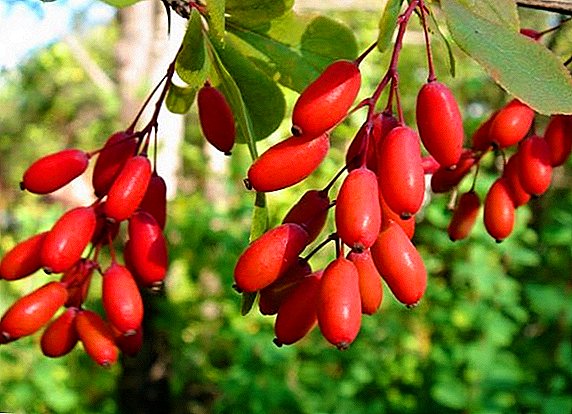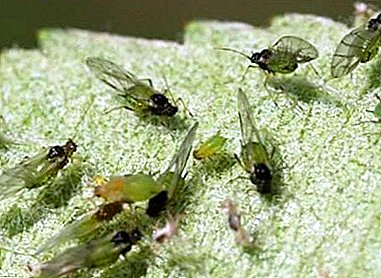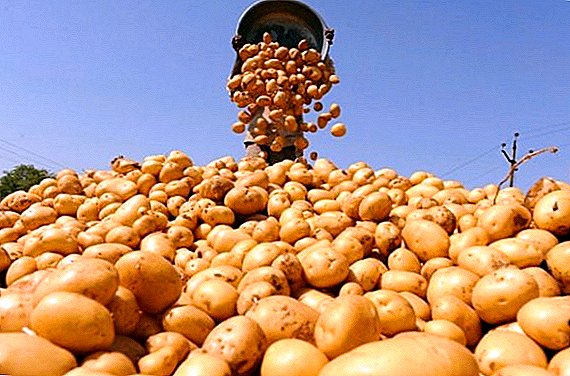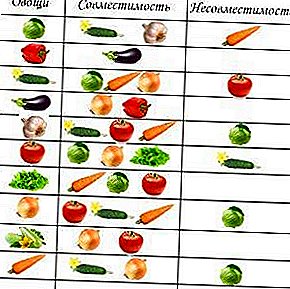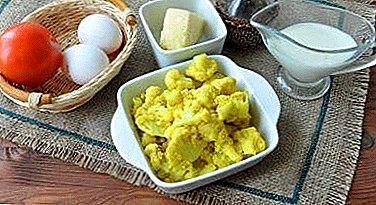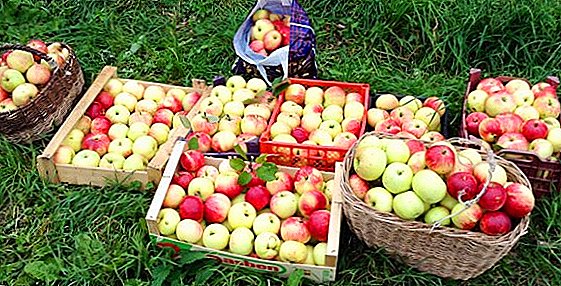 Spring is coming, and at experienced gardeners this time of year is invariably associated with planting seed potatoes in open ground. In this article, we have prepared for you information about the popular variety of potato "Colombo", planting and cultivation of which does not give you much trouble, but the ripening time and the size of the crop will surprise you.
Spring is coming, and at experienced gardeners this time of year is invariably associated with planting seed potatoes in open ground. In this article, we have prepared for you information about the popular variety of potato "Colombo", planting and cultivation of which does not give you much trouble, but the ripening time and the size of the crop will surprise you.
Inference history
The variety "Colombo" ('Colomba') was bred by Dutch breeders by crossing the varieties 'Carrera' and 'Agata'. In the shortest possible time, it gained popularity among agronomists around the world due to its high yield and short maturity of tubers.
Did you know? Residents of European countries until the end of the XVII century considered the potato poisonous and completely unsuitable for eating. He was thrown out and destroyed even in hungry and lean years.
Botanical description of tubers
Tubers of the "Colombo" variety have a rounded shape, their average weight is 90-150 g. The rind is smooth and transparent, pale yellow in color, and the flesh has a yellow tint. The eyes are very small, they lie on the surface level. This is a table variety of potatoes, which has a rich taste, the starch content in tubers is low - 12-15%, but nevertheless the dishes prepared from this variety of potatoes always received the highest marks from their tasters. 
Characteristics of a variety
This type of potato is perfect for cooking any dishes: it can be used both in boiled and fried. We offer you to get acquainted with a more detailed description of the variety "Colombo".
Disease resistance
The potato "Colombo" has high resistance to such popular crop diseases as scab and cancer. Resistance to late blight at an average level, the defeat of fungal diseases most often occurs due to violations of the recommended agricultural practices of cultivation of this variety. Rarely possible defeat bushes golden nematodes.
Terms of ripening
A hybrid variety of potato "Colombo" belongs to the category medium early varieties - ripening occurs in 60-65 days after its landing in open ground. With the recommended landing dates - the beginning of May, the first harvest is ripening by mid-July.
Medium early ripening periods are characteristic for the varieties "Adretta", "Sante", "Ilinsky", "Rodrigo", "Courage".
Yield
 With all the necessary conditions for growing potatoes "Colombo" this variety will be able to please you with a large number of crops.
With all the necessary conditions for growing potatoes "Colombo" this variety will be able to please you with a large number of crops.
On average, from one hectare can be collected from 250 to 400 centners of large fruits of excellent quality.
In the southern regions, it is not uncommon to harvest two harvests in one season.
Stickiness
The degree of stability of this hybrid - 95 %that can be described as "good." By controlling the temperature and degree of air humidity in the vegetable store, you can store "Colombo" without significant losses in the mass of tubers and their table quality, from 4 to 6 months. It should also be noted good transportability and resistance to dark spots that arise from shocks.
Important! According to information from the originator of the variety - HZPC Holland, the variety "Colombo" is sensitive to the lack of elements, in particular, magnesium. To improve the taste of tubers in the period of active growth of bushes, apply fertilizers with a high content of magnesium sulfate.
Growing regions
Growing "Colombo" is possible in the following regions: the south-western and central parts of Russia, the North Caucasus, as well as the north-east of Ukraine. Experienced agronomists say that it is in the Sumy region of Ukraine and in the territories of the Kursk and Belgorod regions of Russia that the highest quantity of the harvested potato of this variety is recorded annually. 
Landing rules
We have prepared for you detailed information about the main principles of cultivating the Colombo variety on your site: the rules of planting and further caring for potatoes are almost the same as those of other varieties of this crop.
Optimal timing
Before planting a variety of "Colombo" pay attention to soil temperature - it should not be below + 7 ° С at a depth of 10 cm. In a temperate climate, these figures correspond to the end of April and the beginning of May. Earlier planting "Colombo" can cause rotting of planting material, which is fraught with complete loss of the future crop.
Did you know? To determine the best time for planting potatoes, you can be guided by folk signs. It is believed that the beginning of flowering dandelions, bird cherries, as well as the blooming of birch buds suggests that there will be no cold snaps and you can safely plant potatoes.
Location selection
For the cultivation of potatoes "Colombo" choose well lit areas, while the soil should not be lacking in moisture. It is advisable to plant the beds in a southerly direction - so you will be sure that every bush during the day received the necessary portion of sunlight. Pay attention to the level of groundwater flow - they should be no closer than 80 cm to the surface of the earth. 
Good and bad predecessors
When growing any crops, plants that previously grew in their place have a great influence on the quality of their crops. Experienced agronomists have long noticed that potatoes grow better, produce more crop and become less susceptible to disease if you planted it in the soil where such crops grew: beets, mustard, onions, radish, cucumber, legumes, rapeseed and carrots.
Familiarize yourself with the basics of vegetable crop rotation.
But its planting in the ground after tomatoes, cabbage, eggplants and pepper can significantly worsen the table quality of tubers and the appearance of the bushes - after these crops, the soil in the area remains infected with diseases and pests that pose a danger to your potato beds. In order not to overly deplete the soil, it is recommended to regularly transplant potato bushes to new places every 3-4 years.
Soil preparation
This stage is one of the main rules for growing vegetables.  We will tell you in more detail what is included in annual site preparation for potatoes:
We will tell you in more detail what is included in annual site preparation for potatoes:
- Autumn preparation. It is carried out immediately after harvesting and before the onset of the first frost. There are two ways to cultivate the land in the autumn. The first option: you carefully dig the land, while the shovel must enter the soil until the bayonet. In the process of digging, weeds and roots of other crops are removed, in addition, special attention is paid to cleaning the soil from insect larvae, worms and other pests. Next, fertilizers are applied, for example, humus, at the rate of 5-7 kg per square meter. The second variant of soil preparation includes planting of the site with green manure plants. These include: chickpeas, canola, rye, wheat, lupine, peas, corn, oats, mustard, sweet clover, alfalfa, phacelia. In the process of growth, these plants saturate the soil with useful elements, make it looser, and also significantly improve the quality of the crop and the growth rate of potato bushes. Instead of digging up the plot, you sow it with these crops and wait for the first shoots. After the sprouts get stronger, you cut them and leave to spend the winter on the site. To maximize the enrichment of the soil, you can pour a layer of earth on top.
- Spring Training includes shallow soil loosening. This can be done with a rake or fork, which should loosen the ground and break up large lumps. However, if you notice that after wintering, the soil is overgrown with weeds, then in this case it is best to use re-digging the plot. As a rule, after autumn digging, the depth of soil damage by weeds is already smaller, therefore the volume of work is significantly reduced.

Preparation of planting material
In order for the potatoes to be able to simultaneously please you with strong and fast shoots, which are transformed into a sprawling bush with large tubers under the ground, planting material needs preliminary preparation:
- Dry germination. Such preparation should begin about a month before the planned landing date. The main role in this process belongs to the bright lighting and warm air in the room. Selected tubers "Colombo" are arranged in one row in a box or other capacity, the sides of which do not prevent the penetration of light. The first 10-14 days it is important to maintain the temperature at + 18-21 ° C - the warm air will “revive” the potatoes and start the process of growing the eyes. The next step in the dry germination will be a gradual decrease in temperature to the mark of + 10 ° C. At this temperature, the storage of tubers continues until they are planted in open ground.
- Wet germination. This method of preparation involves storing seed in a dark room, and the air temperature should not exceed + 15 ° C. The main feature of wet germination is to cover the tubers with a small layer of wet soil or sawdust. For timely germination of the eyes, it is important to regularly moisten the substrate as it dries. Wet germination reduces the time of preparation of tubers for sowing in open ground up to 2-3 weeks.
- Seedling method. This method of tuber preparation is used in cases of enhanced germination of the eyes before you begin their preparation for planting in the soil. So that the planting material of the "Colombo" variety does not waste extra forces on unnecessary shoots, you should wait until they grow to 5-6 cm in length, and at their base there will be visible rudiments of the roots. After that, carefully separate each from the tuber and deepen them into the nutrient mixture. The recommended spacing between sprouts is at least 6 cm. After the seedlings have got stronger, it can be planted in open ground. If the optimum temperature and humidity conditions are observed, sprouts can appear on the tubers several more times, which makes this method very convenient when you have a small amount of seed.



Scheme and depth of landing
When planting "Colombo" experienced gardeners recommend digging holes at a distance of 30 cm from each other, between the beds there must be at least 70 cm of free space - for spreading potato bushes this distance will be optimal for the proper development of the root system of the plant.
Did you know? In Alaska, in the days of the gold rush, many prospectors had scurvy. It was possible to replenish the supply of vitamins in the body with the help of potatoes, the market price of which at that time was almost as good as the value of gold mined.
How to care
Almost all varieties of potatoes do not require special skills during their cultivation. There are key points that should not be neglected in the process of caring for a variety of "Colombo". Let's tell about them in more detail.
Watering
There are five rules for proper watering of this crop:
- Regular watering begins only after the sprouts have grown strong and have reached 15 cm in height. Shoots that have not managed to overcome this mark, are considered weak, and moisture can cause the process of decay in planted tubers.
- Watering is carried out with water heated to air temperature. Cold water has a detrimental effect on the delicate roots, thereby can start the process of their decay. Leave the water intended for irrigation in the sun for a couple of hours - it will heat it to the optimal parameters.
- Adjust the amount of watering depending on the periods of plant growth. During the formation of buds and the active growth of tubers, increase watering by 1-2 liters under each bush. The rest of the time - do not exceed the volume of 4 liters per bush.
- On days with moderate temperature and humidity, watering is carried out no more than once a week. And with the onset of summer heat, you can water every two or three days.
- Do not immediately pour the entire volume of water under the root of the plant. To avoid scouring the roots, do it in portions - no more than a liter at a time. Pour a batch, let it soak into the soil, and then start watering again.

Top dressing
In addition to fertilizing at the time of planting "Colombo", this variety needs additional feedings during the entire period of its growth. It can be like root dressings - fertilization at the root, and outdoorwhich means sprinkling potato tops.
The most effective way is considered to be feeding directly under the root of plants. Between two bushes you need to drive a stake to a depth of no more than 20 cm - for these purposes it is convenient to use a cutting from a shovel. In the resulting hole pour the prepared solution and thus fertilize the rest of the bushes. This method is good because the plant will independently take the necessary amount of useful substances, and the roots will not suffer from the abundance of fertilizers.
The most common use of diluted chicken litter with water in this proportion is 1 part of the litter and 2 parts of water. In the solution, you can add ash or bone meal in a small amount. If you live near water bodies, then swamp silt or tin may also become a source of nutrients for potato beds.
Learn more about the timing and fertilizer for feeding potatoes.
The first feeding "Colombo" can be started a month after it is planted in open ground. The next fertilization plan for the period of formation of buds, and then - after the flowering of potatoes.
Video: Potato feeding
Weeding and loosening the soil
Good air exchange in the soil helps to saturate it with useful elements, which are especially important for germinating tubers, besides, loose soil warms up faster under the spring sun. Experienced agronomists advise start loosening the beds within a few days after spring planting tuber "Colombo". As the seedlings grow, this procedure should be done regularly - after the precipitation and always as a hard earthen crust is formed. Do not forget about weed cleaning - during loosening, you may come across their roots, which should be pulled out carefully.
Important! When hilling potato bushes or loosening them, do not put a rake or hoe too deep into the soil. Their root system is close to the surface, so it is very easy to injure potatoes.
Hilling
To significantly accelerate the growth of potato varieties "Colombo", used hilling his bushes. This procedure implies spreading loose soil under the roots of a plant, thereby forming a small mound. The first time you need to spud after the sprouts have grown to 15 cm in height, about 20 days later the hilling is done again. To preserve moisture in the soil, it is advisable to do it in the early morning or after sunset. It is best to water the beds before hilling or to hold it right after the rain. 
Preventive treatment
For the "Colombo" variety, various diseases are dangerous, as well as pests that are not averse to eating your crop. Reduce the risk of meeting with such troubles on the beds can their preventive treatment.
For processing from fungal diseases the following drugs are used: "Epin", "Ditan M-45", "Krezacin", as well as copper sulphate solution. And drugs such as Aktara, Fitoverm, Bicol, and Mospilan can get rid of insects, larvae, beetles, and other pests from your beds. Remember that the processing of chemicals is carried out in calm weather in the early morning or late evening. Be sure to use protective equipment and wash your hands thoroughly with soap and water after the procedure.
Important! If during the flowering of potatoes you notice pests attacking the bushes, do not rush to spray the beds with chemical means. Flowers are of interest to bees and other pollinating insects, so this treatment can destroy them.
Harvesting and storage
By collecting "Colombo" you can start without waiting for the yellowing of his tops. To speed up the process of ripening tubers, you can advance cut off the ground part of the bush - This should be done about a week before the estimated date of collection. Green tops should be immediately removed from the site - it can become a haven for many pests.  Dig one bush to determine the exact degree of maturity of the potato: if the diameter of the tubers is at least 3-5 cm, then you can safely continue their digging. Sick tubers set aside from healthy ones - their simultaneous storage can completely infect the entire crop. After digging up the tubers, they are left to dry in the beds for several hours - this measure is an excellent prevention of fungal diseases, and also contributes to the coarsening of potato skins.
Dig one bush to determine the exact degree of maturity of the potato: if the diameter of the tubers is at least 3-5 cm, then you can safely continue their digging. Sick tubers set aside from healthy ones - their simultaneous storage can completely infect the entire crop. After digging up the tubers, they are left to dry in the beds for several hours - this measure is an excellent prevention of fungal diseases, and also contributes to the coarsening of potato skins.
Before sending the potatoes for storage, they are sorted out and cleaned of clods of earth and grass residues. Tubers with signs of damage should be eaten immediately - they are not suitable for long-term storage.
It is convenient to store potatoes in containers and boxes located in special vegetable storehouses, where the optimum ratios of temperature and humidity are maintained. If you grow "Colombo" in a small amount, then store it in the basement or cellar. The air temperature should not rise above + 4 ° С, and the air humidity indicators should be at the level of 75-80%.
Read also about the proper storage of potatoes and other vegetables, as well as about the particular storage of potatoes in the apartment.
Advantages and disadvantages
To main merits This variety can include the following:
- early ripening;
- excellent dining qualities;
- high yield;
- good resistance to many "potato diseases", among which are dangerous for the harvest diseases such as scab and cancer.
The main disadvantage varieties can be called its sensitivity to waterlogging and freezing of the soil.
Video: Colombo potato growing
Now you know that the variety "Colombo" does not require special skills and abilities in care. Guided by the recommendations for its cultivation, taken from our article, you can provide it with all the necessary conditions, and the reward will be high yield and excellent taste of dishes prepared from this potato.


